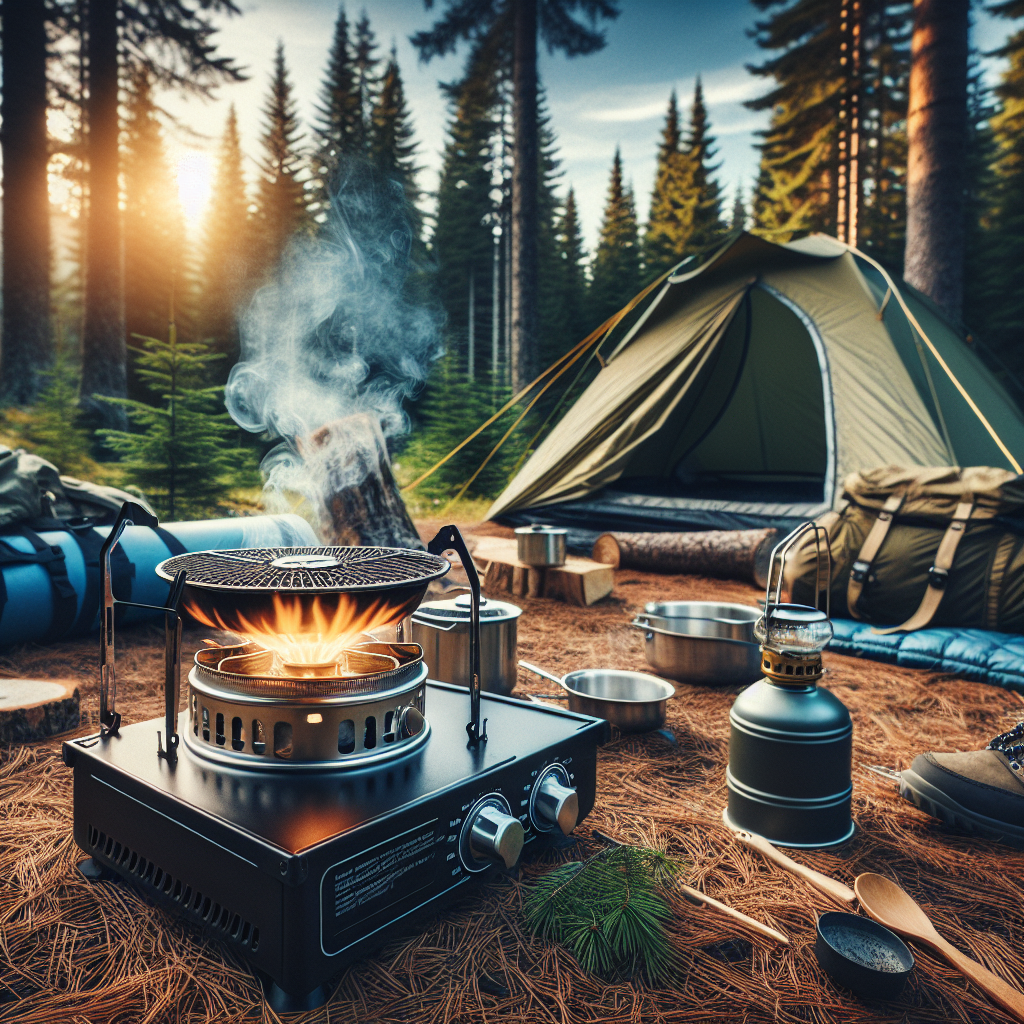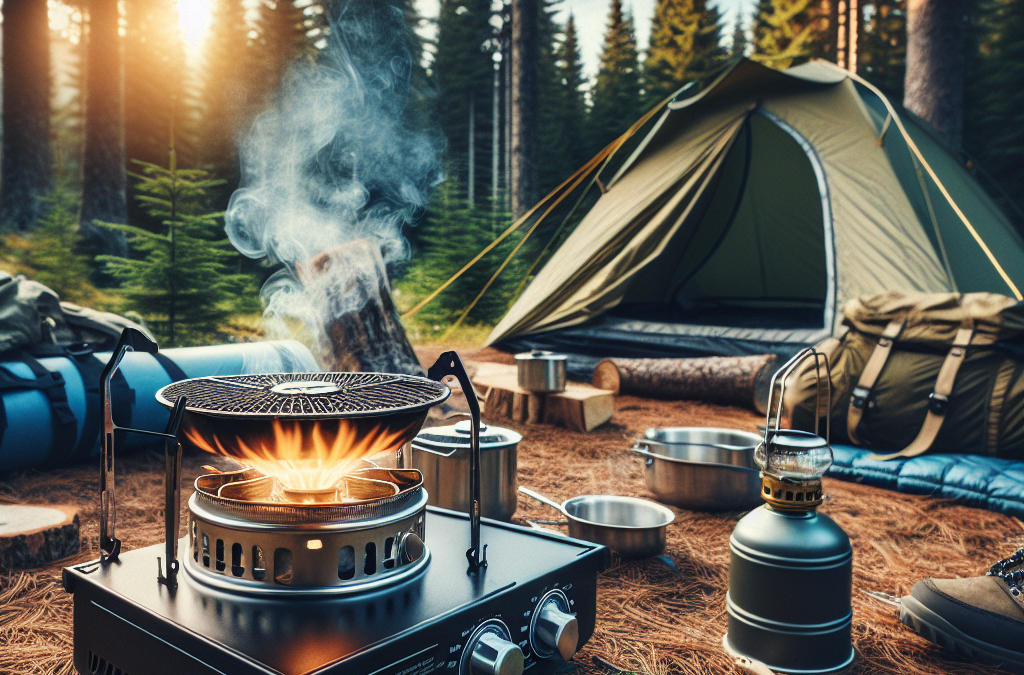Imagine yourself in the great outdoors, feeling the fresh breeze caressing your face as you set up your camp. Now comes the exciting part – cooking your meals, not in the comfort of your kitchen, but amidst nature. One essential tool you need is a portable stove. In the article “Cooking With Portable Stoves: A Guide For Campers”, you’ll learn everything you need—from understanding different types of stoves to tips on setting them up, safe usage, and even a few simple recipes you can try. The objective: to transform your camping meal experience into an adventure you’re sure to love. Let’s embark on this culinary journey!
Understanding Portable Stoves
What is a portable stove?
A portable stove is a lightweight, easy-to-carry cooking device that is specially designed for outdoor use. It is a boon for campers, backpackers, and anyone who loves to picnic or cook outdoors. Portable stoves can provide a convenient and reliable heat source in locations where traditional stoves are not practical or available.
Types of portable stoves
There are several types of portable stoves available, each with its own set of benefits and drawbacks. The most common types include propane stoves, butane stoves, alcohol stoves, and wood-burning stoves. Propane and butane stoves are popular because they’re easy to use and provide quick heat. Alcohol and wood-burning stoves, on the other hand, require you to carry fuel but are generally lighter and more packable.
How portable stoves work
Portable stoves work by burning a fuel source to produce heat. The heat source can be a flammable gas such as propane or butane, or it can be liquid alcohol or wood. The stove has a burner where the fuel is ignited and controlled. You place your pot or pan on top of the burner, and the heat from the flame cooks your food.
Choosing the Right Portable Stove for Camping
Factors to consider
When choosing a portable stove for camping, consider factors like weight, fuel type, number of burners, and stove design. For instance, if you’re backpacking, you’ll want a lightweight stove. If you’re cooking for a large group, you might want a stove with multiple burners.
Recommendations for different types of camping trips
If you’re car camping and weight isn’t an issue, a larger propane stove with two burners is ideal. For backpacking, an ultralight alcohol or wood-burning stove is a good option.

Setting Up Your Portable Stove
Unpacking your stove
After reaching your campsite, carefully unpack your portable stove from its carrying case. Make sure all parts are accounted for and in good working order.
Choosing a good location
Choose a flat and stable surface to set up your stove. It should be a safe distance from flammable materials like dry grass, leaves, or tent materials.
Steps for setup
Setting up a portable stove usually involves connecting the fuel source, opening the fuel valve, priming the stove (if required), and igniting the burner. Always follow the manufacturer’s instructions for safe setup and use.
Safe Use of Portable Stoves
General safety guidelines
Always use your stove in a well-ventilated area to avoid carbon monoxide poisoning. Never leave your stove unattended while it’s on.
Precautions while handling fuel
When handling fuel, be careful not to spill it on your skin or clothes. Always ensure the fuel cap is tightly closed when not in use. Always store fuel in a cool, dry place away from flames or sparks.
Proper maintenance of portable stoves
Regularly clean and maintain your stove to ensure it operates safely and efficiently. Check for leaks, cracks, or other damage before each use.
Emergency procedures
If your stove catches fire, turn off the fuel source immediately if it’s safe to do so. Use a fire extinguisher or douse with water if necessary. Never attempt to move a stove that’s on fire.

Cooking Basics on a Portable Stove
Adjusting heat levels
Many portable stoves allow you to adjust the heat level, just like your stove at home. Simply turn the fuel control valve to increase or decrease the heat.
Cooking times
Cooking times can vary depending on the type of stove and fuel you’re using. It’s a good idea to do a test run at home to get a feel for how quickly your stove heats up and cooks.
Methods of cooking suitable for portable stoves
You can use portable stoves for various cooking methods, including boiling, simmering, sautéing, and even baking with the right accessories.
Pro Tips for efficient cooking
For efficient cooking, use a windscreen to protect the flame from wind, and use a lid to trap heat and reduce cooking time. Preparing and measuring ingredients beforehand also makes cooking easier and quicker.
Recipes Ideal for Portable Stove Cooking
Quick and Easy Breakfast
For breakfast, consider quick-cooking foods like oatmeal or scrambled eggs. Both are easy to prepare and require only a single burner.
Delicious Lunch and Dinner Ideas
For lunch or dinner, try one-pot meals like pasta, rice dishes, or soups. These are easy to prepare and minimize cleanup.
Snacks and Deserts to Try
For snacks, try roasting marshmallows or making smores. For dessert, try baking a simple cake or brownies in a dutch oven.
How to prepare a multi-course meal on a portable stove
With careful timing and planning, you can prepare a multi-course meal on a portable stove. Begin by cooking dishes that can hold well (like soup), followed by quick-cooking or last-minute items.
Cleaning and Maintaining your Portable Stove
Regular cleaning practices
Regular cleaning can extend the life of your stove and keep it running efficiently. Wipe down your stove after each use to remove residue or food particles.
Detailed step-by-step cleaning process
A detailed cleaning involves disassembling the stove to clean individual parts. Always consult your stove’s manual for specific cleaning instructions.
Storage tips
Store your stove in a dry location to prevent rust or damage. It’s best to store it in its original carrying case to protect it from dust and moisture.
Troubleshooting common issues
If your stove isn’t working properly, consult your stove’s manual or contact the manufacturer for troubleshooting advice. Common issues might include a blocked fuel line or burner, a broken igniter, or leaks.
Comparative Review of Popular Portable Stove Brands
Key features to look for in a good portable stove
Important features might include fuel efficiency, ease of use, weight, and durability. Check reviews and ratings before making your final decision.
Pros and Cons of popular brands
Each brand of portable stoves has its pros and cons. Familiar brands like Coleman, MSR, and Jetboil have reputations for quality and reliability, but may be more expensive.
Price comparison
Portable stoves range in price from around $20 for basic models to several hundred for high-end stoves. Consider your budget and how often you’ll be using the stove when deciding how much to spend.
Accessories to Enhance your Portable Cooking Experience
Must-have accessories
Must-have accessories include a sturdy pot or pan, spatula or cooking spoon, and a windscreen. A fuel canister stand can provide stability, and a carrying case can make transport easier.
Luxury add-ons worth considering
Luxury add-ons might include a double burner stove, a dutch oven for baking, or a portable grill for barbecuing.
Where to buy
Portable stoves and accessories can be purchased at outdoor gear stores, general department stores, or online retailers like Amazon.
Real-life Camping Experience with Portable Stoves
Personal experiences from seasoned campers
Seasoned campers often have stories about using their stoves in various conditions and settings – from mountain tops to sandy beaches. They often have tips and tricks about using and maintaining stove.
Survival stories involving portable stoves
In survival situations, a portable stove can be a lifesaver. There are plenty of stories about people using stoves to cook food, boil water, or even signal for help.
Tips and tricks learned from experience
Experience is the best teacher when it comes to using portable stoves. Trial and error will teach you which foods cook well on the stove, how to adjust the heat for optimal cooking, and how to handle and store the stove safely.

